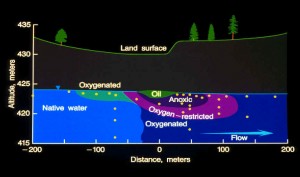Field Sites and Background
Bemidji, Minnesota
One site is located in northern Minnesota near the town of Bemidji. On 8/20/79, a pipeline burst, dispersing approximately 1670 m3 of crude oil. Beneath the break, a floating pool of free-product ~ 1 m thick collected on the water table, and a plume of DOC formed downgradient from the source (Hult, 1984, Baedecker et al., 1993). The aquifer consists of glacial sand and gravel outwash with ferric oxyhydroxide coatings. The chemistry of the groundwater immediately affected by the spill is characterized by five different zones (Bennett et al., 1993). The groundwater changes from native, pristine water to petroleum-contaminated water with a decrease in concentration of O2, to a reducing, high DOC environment beneath the floating pool of oil, with a transition back to oxidizing, low DOC conditions beyond the plume.
The oil spilled at Bemidji is a light aliphatic crude, although high concentrations of benzene and alkylbenzenes are found in the anoxic zone with smaller concentrations downgradient in the oxic zone (Eganhouse et al., 1993). Organic chelates produced from microbial degradation of the oil are present only in the anoxic region beneath the floating free product (Cozzarelli et al., 1990). Hydrocarbons in this zone are microbially degraded by iron (III) reduction and methanogenesis.
The native microbial population in the anaerobic ground water consists of iron reducers, fermenters and methanogens, with as many as 106 per gram of soil, and methanogens 10-50% of that number (Essaid et al., 1995), while the aerobic groundwater is host to a variety of aerobes. Approximately 95% of the microorganisms are sessile, but the planktonic distribution is a good representation of the sessile population (Bekins, pers. com.).
Red Lake Peatlands, Minnesota
The boreal Lost River peatland is part of a mire deposited on the bed of glacial Lake Agassiz. Peat accumulates to an average depth of 3 m, and the area contains many hydrogeologic and geochemical zones. A comparison will be made between a spring fen and a raised bog, two areas in the peatland which display distinctive hydrogeologic and chemical characteristics. The spring fen is a year-round discharge zone, while seasonal fluctuations in ground water flow cause the raised bog to act as a recharge and discharge zone. This causes a stagnation zone at depth. The spring fen is characterized by oxic conditions at circum-neutral pH. The raised bog is characterized by oxic and acidic conditions at the surface, with pH increasing with depth until pH is circum-neutral and conditions are anoxic. Silicate silt grains taken from the deep, anoxic zone of the raised bog are highly etched, while grains from the surface of the bog and the spring fen show minimal chemical weathering. Accelerated weathering of the silicate grains is attributed to complexation by organic ligands produced from metabolism of DOC by indigenous microbes (Bennett et al., 1991).


